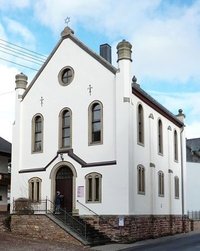The Joseph family operated their matzo bakery in the Kirchgasse only a few meters from the synagogue in Laufersweiler. They supplied Jewish communities as far away as in France and Luxembourg with unleavened bread so, especially around Passover, bustling activity dominated their small family business. This picture from 1937 shows the Joseph family with their employees and both children, Ruth and Heinz, as well as the Rabbi (front, centre) who lived with them in order to oversee the production process at that time. The workforce was made up of both Jews as well as Christians, and the Joseph family often took in some of the employees. Heinz Joseph later recalled: „We always had a rabbi living in the house with us during this time, so we also had to live kosher and – in addition to all the other rules – had to observe every Jewish law, as well.“
The Joseph family was also among those attacked during the “Reichspogromnacht”: SS henchmen drove them out of the house and smashed windows while demolishing their private and business premises. Heinz, Ruth and their mother, Gertrude, found refuge at the neighbouring home of a Catholic priest, who hid and protected them from further harm. But, as a consequence of the Pogrom Night, Gertrude felt compelled to send her children by themselves to safety abroad; the matzo bakery never opened for business again. Ruth was taken in as a housemaid by a family in Holland, but was deported to Auschwitz from Westerbork in 1942. Heinz lived with relatives in Luxembourg, but was deported via Lodz to Auschwitz-Birkenau. He was ultimately freed from Bergen-Belsen in 1945 and survived the Holocaust as the only member of his family. He emigrated to the USA in 1947, where he took on the name Henry Joseph. In an interview with the Shoah Foundation in 1996, he talked about his childhood in Laufersweiler and reflected on the separation from his family.
Matzo is the name given to the unleavened bread baked for and consumed at Passover. It is meant to remind the Israelites of their hasty exodus from Egypt and their delivery out of slavery. There was no time to allow the bread dough to ferment, or leaven, as they were preparing to flee Egypt, so matzo is baked only using flour and water. Traditional matzo is also produced in haste, as preparation of the bread must not take more than 18 minutes. Hence, a trained rabbi, or so-called mashgiach, supervises the process to ensure that Jewish dietary rules are complied with and subsequently designates the product as being „kosher“.
de

